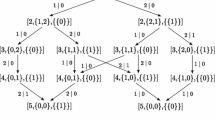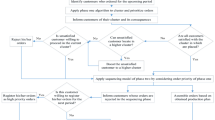Abstract
This paper introduces a beam search approach to sequencing mixed-model assembly lines and compares that approach to existing sequencing heuristics. The comparison study consists of over 400 test problems that vary in terms of number of product models, quantity of assembly, and degree of component commonality. The results show that beam search techniques are clearly superior to both the goal chasing algorithm (GCA) and Miltenburg and Sinnamon's look ahead heuristic. The second half of this paper extends the beam search approach to allow two scheduling objectives: (1) minimizing parts consumption variation, and (2) minimizing workload variation. Termed filtered beam, this variation uses a filter to eliminate alternatives that exceed a predetermined threshold according to one objective, and then proceeds with the beam search for the second objective. As in the first case, optimization is not guaranteed; however, the filtered beam search provides a frontier of good trade-off solutions from which the decision maker can choose an acceptable sequence.
Similar content being viewed by others
References
J.F. Bard, E. Dar-El and A. Shtub, An analytic framework for sequencing mixed model assembly lines, International Journal of Production Research 30,(1992)35–48.
A. Barr and E.A. Feigenbaum, The Handbook of Artificial Intelligence, Vol. 1, Heuris Tech Press, Stanford, 1981.
P. Dileepan and T. Sen, Bicriterion static scheduling research for a single machine, Omega International Journal of Management Science 16(1988)53–59.
F.Y. Ding and L. Cheng, A simple sequencing algorithm for mixed-model assembly lines in just-in-time production systems, Journal of Operations Management 11(1993)45–50.
M. Fox, Constraint-directed search: A case study of job-shop scheduling, Ph.D. Dissertation, Carnegie-Mellon University, 1983.
R.W. Hall, Cyclic scheduling for improvement, International Journal of Production Research 26 (1988)457–472.
A. Hertz and D. de Werra, Using tabu search techniques for graph coloring, Computing 39(1987) 345–351.
R.R. Inman and R.L. Bulfin, Sequencing mixed-model assembly lines, Management Science 37 (1991)901–904.
M.S. Fox, Constraint-guided scheduling — a short history of research at CMU, Computers in Industry (May 1990)79–88.
L.H. Koopmans, An Introduction to Contemporary Statistics, Duxbury Press, Boston, 1981.
W. Kubiak, Minimizing variation of production rates in just-in-time systems: A survey, European Journal of Operational Research 66(1993)259–271.
W. Kubiak and S. Sethi, A note on level schedules for mixed-model assembly lines in just-in-time production systems, Management Science 37(1991)
Y. Leu, T. Rakes, L. Rees and W. Ceccucci, Modelling resource allocation in a decentralized organization with an AI-based, goal-directive model, Decision Sciences 23(1992),1027–1049.
B.T. Lowerre, The HARPY speech recognition system, Ph.D. Dissertation, Carnegie-Mellon University, 1976.
G.J. Miltenburg, A theoretical basis for scheduling mixed-model production lines, Management Science 35 (1989)192–207.
J. Miltenburg and G. Sinnamon, Scheduling mixed-model multi-level just-in-time production systems, International Journal of Production Research 27(1989)1487–1509.
Y. Monden, Toyota Production System, 2nd ed., Industrial Engineering and Management Press, Atlanta, GA, 1993.
K. Okamura and H. Yamashita, A heuristic algorithm for the assembly line model-mix sequencing problem to minimize the risk of stopping the conveyor, International Journal of Production Research 17(1979)233–247.
P.S. Ow and T.E. Morton, The single machine early/tardy problem, Management Science 35(1989) 177–190.
P.S. Ow and S.F. Smith, Viewing scheduling as an opportunistic problem-solving process, Annals of Operations Research 12(1988)35–62.
S. Rubin, The ARGOS image understanding system, Ph.D. Dissertation, Carnegie-Mellon University, April 1978.
SAS User's Guide, SAS Institute Inc., Cary, NC, 1991.
G. Steiner and S. Yeomans, Level schedules for mixed-model, just-in-time processes, Management Science 39(1993)728–735.
R.T. Sumichrast and R.S. Russell, Evaluating mixed-model assembly line sequencing heuristics for just-in-time production systems, Journal of Operations Management 3(1990)371–390.
R.T. Sumichrast, R.S. Russell and B.W. Taylor, Comparative analysis of sequencing procedures for mixed-model assembly lines in a just-in-time production system, International Journal of Production Research 30(1992)199–214.
Rights and permissions
About this article
Cite this article
Leu, Yy., Huang, P.Y. & Russell, R.S. Using beam search techniques for sequencing mixed-model assembly lines. Annals of Operations Research 70, 379–397 (1997). https://doi.org/10.1023/A:1018938608304
Issue Date:
DOI: https://doi.org/10.1023/A:1018938608304




